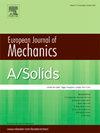Prediction model of dynamic fracture toughness of nickel-based alloys: combination of data-driven and multi-scale modelling
IF 4.2
2区 工程技术
Q1 MECHANICS
引用次数: 0
Abstract
The dynamic fracture toughness of nickel-based alloys is closely related to both the internal strengthening phases and external impact loads. However, the prediction of fracture toughness is challenging due to complex factors such as multi-scale effects, non-linearity, and strong correlations. To address these challenges, a novel prediction method for the dynamic fracture toughness of nickel-based alloys has been proposed, which integrates multi-scale numerical simulations (physical models) with machine learning techniques. This method considers both external factors (impact velocity) and internal factors (the size and distribution of strengthening phases).The study analyzes the correlation between impact velocity, the size and distribution of strengthening phases, and dynamic fracture toughness. It also proposes an optimization strategy for the hidden layer depth and the number of neurons in the neural network, resulting in an optimal network structure (8 layers with 25 neurons per layer) for predicting dynamic fracture toughness. Based on this optimized network structure, the study identifies the optimal sample size (N = 90) for ensuring a balance between computational efficiency and prediction accuracy in the fracture toughness model. Furthermore, a comparative analysis is conducted on the fitting and prediction performance of various machine learning models, including artificial neural networks (ANN), support vector machines (SVM), k-nearest neighbors (KNN), and decision trees (DT). Among these, the ANN model demonstrates the best performance, with an average absolute error of 6.73 and a coefficient of determination (R2) of 0.98. Additional validation confirms the model's excellent capability for both interpolation and extrapolation.This research successfully achieves accurate predictions of the dynamic fracture toughness of nickel-based alloys, incorporating physical information transfer. It provides new insights for the design and service performance optimization of nickel-based alloy materials.
镍基合金动态断裂韧性预测模型:数据驱动与多尺度建模相结合
镍基合金的动态断裂韧性与内部强化相和外部冲击载荷密切相关。然而,由于多尺度效应、非线性和强相关性等复杂因素,断裂韧性的预测具有挑战性。为了解决这些挑战,提出了一种新的镍基合金动态断裂韧性预测方法,该方法将多尺度数值模拟(物理模型)与机器学习技术相结合。该方法同时考虑了外部因素(冲击速度)和内部因素(强化相的大小和分布)。研究分析了冲击速度、强化相的大小和分布与动态断裂韧性之间的关系。提出了隐层深度和神经网络中神经元数量的优化策略,得到了预测动态断裂韧性的最优网络结构(8层,每层25个神经元)。基于优化后的网络结构,本研究确定了保证断裂韧性模型计算效率和预测精度平衡的最优样本量(N = 90)。对比分析了人工神经网络(ANN)、支持向量机(SVM)、k近邻(KNN)和决策树(DT)等机器学习模型的拟合和预测性能。其中,人工神经网络模型表现最好,平均绝对误差为6.73,决定系数(R2)为0.98。额外的验证证实了该模型具有出色的内插和外推能力。该研究成功地实现了镍基合金动态断裂韧性的准确预测,并结合了物理信息传递。为镍基合金材料的设计和使用性能优化提供了新的思路。
本文章由计算机程序翻译,如有差异,请以英文原文为准。
求助全文
约1分钟内获得全文
求助全文
来源期刊
CiteScore
7.00
自引率
7.30%
发文量
275
审稿时长
48 days
期刊介绍:
The European Journal of Mechanics endash; A/Solids continues to publish articles in English in all areas of Solid Mechanics from the physical and mathematical basis to materials engineering, technological applications and methods of modern computational mechanics, both pure and applied research.

 求助内容:
求助内容: 应助结果提醒方式:
应助结果提醒方式:


